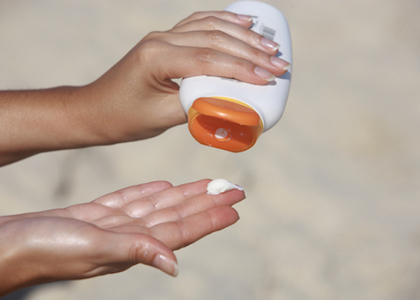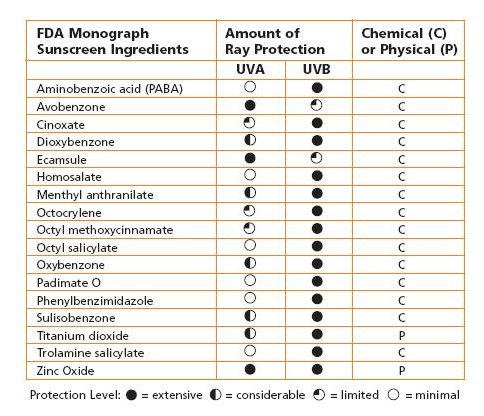
Is Sunscreen Safe? 10 Facts You Should Know
By Claire Georgiou, Reboot Naturopath, B.HSc ND
Most sunscreens contain a large array of chemicals, some of which could be a potential health concern, especially as you slather sunscreen on a large surface area of skin repeatedly.
I sat up and paid attention when I heard that 85 percent of breast milk samples in studies contained sunscreen chemicals long after sunscreen use.
Learn about the toxicity of sunscreen chemicals in this Sunscreen Guide by the EWG. Highly recommended reading and Table 1 is of particular interest.
There is much controversy suggesting that sunscreens may in fact increase the risk of some forms of skin cancer particularly the more deadly types and may increase the risk of other types of cancer. As the use of sunscreens has dramatically increased so has skin cancer and it continues to climb at an alarming rate. There are a number of theories as to why this may be possible:
1.) People believe that using sunscreen gives them full protection against the harmful effects of the sun and unfortunately this is not the case. This gives people a false sense of security so they then remain in the sun for longer periods of time.
2.) Many sunscreen chemicals do not undergo full photocarcinogenic testing before they are released onto the market.
3.) Some sunscreen ingredients such as oxybenzone, benzophenone, octocrylene, or octyl methoxycinnamate may be potentially carcinogenic or have other health risks. Research has found that many sunscreens contain chemicals that are estrogenic, disrupt the endocrine system and may play a significant role in some forms of cancer such as breast cancer development.
4.) Chemical sunscreens have inferior stability, penetrate the skin and may disrupt the body’s hormone system.
5.) The sunscreen industry adds a form of vitamin A listed as retinyl palmitate or retinol to nearly one-quarter of all sunscreens. Studies indicate that it may speed the development of skin tumors and lesions when applied to skin in the presence of sunlight. EWG recommends that consumers avoid sunscreens, lip products and skin lotions containing vitamin A.
6.) It is said that the protection that is offered against UVB rays in sunscreen may stop you from noticing that you are still in fact burning from the UVA rays which are still present and can be a reason for why non-sunscreen users may NOT get the same amounts of melanoma that the sunscreen users get. They basically feel the burn so they avoid any more exposure.
7.) SPF rates the sunscreens ability to protect the skin from UVB rays but does not indicate the level of protection against UVA rays which penetrates the deeper levels of the skin and can have the most damaging effects.
8.) Nano-particles are a possible concern for skin and organ health which are commonly used in sunscreens. In Australia Friends of the Earth(FOE) conducted a study to determine which sunscreens were nano free and unfortunately many contained nano particles and labelling is not required. These particles are so small that they may potentially get into any body tissue and cells and possibly disrupt normal healthy cells. Animal studies indicate they may have detrimental health effects so it is agreed amongst many including the Cancer Council of Australia that it is still a potential health concern.
9.) Sunscreen blocks vitamin D production by 95% which in fact protects against many forms of cancer including skin cancer.
10.) Most sunscreen products are formulated with synthetic fragrance chemicals, parabens, phthalates, harsh alcohols, toxic chemical solvents and petroleum. Here is more on harsh skin chemical products that also can be found in sunscreen – 9 skin care products to avoid.
Since UVA’s are inherently more damaging AND persistently high during all daylight hours, wearing a sunscreen that doesn’t protect you from UVA is going to give you virtually no benefit and be detrimental to your overall health. So it’s important to understand that if you’re using sunscreen, you need to be certain you are actually getting UVA protection.
The Environmental Protection Agency‘s graph below lists chemical and physical sunscreen ingredients, as well as the type and amount of ray protection that they provide and their class.
Make your own sunscreen!
Get a bottle of 100g of natural chemical & fragrance free cream and add 2 Tablespoons of Zinc Oxide and mix well. Use as a sunscreen.
Since sunscreens do not protect you against all of the damaging effects from the sun and due to this it is important to fully protect yourself and your family with these extra measures:
1.) Minimize peak hours of sun exposure between 10am-2pm and up to 3pm in Australia.
2.) Wear a wide brimmed hat.
3.) Wear protective light clothing.
4.) Sit under available shade where possible.
5.) Wear UV protective eyewear.
6.) Apply natural protective sunscreen.
And remember you can protect yourself from the damaging effects of the sun by what you eat! Here is more on how to naturally protect your skin from the sun with food!
